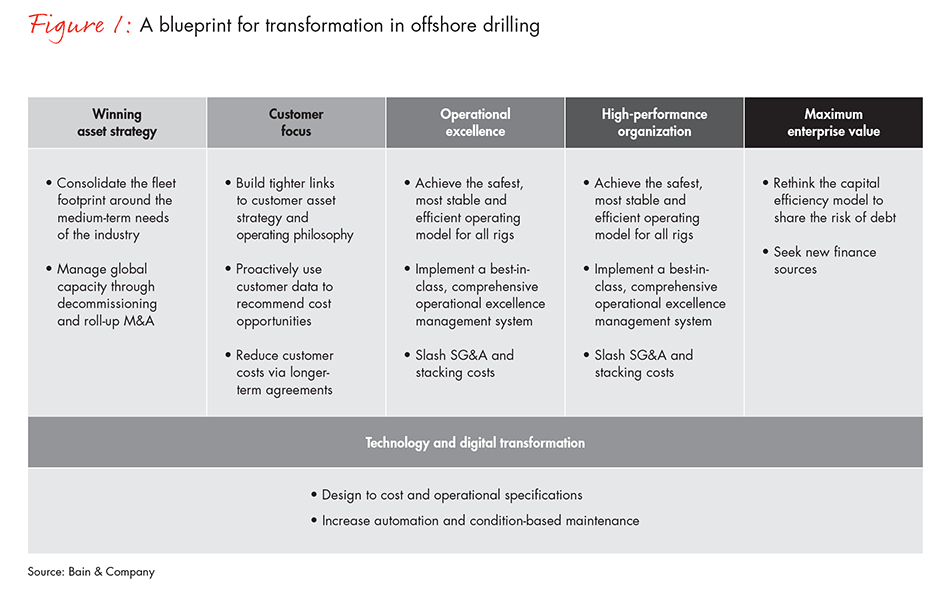Brief
 }
}
Even before oil prices began to drop in the summer of 2014, day rates for drilling rigs had begun to sag due to overcapacity in the market. Since then, as the price of oil has dropped by 70%, offshore operators have put tremendous pressure on their suppliers, asking them to help reduce the total costs of offshore production and keep their barrels competitive. Drillers saw their rates cut in half, and customers began asking for the lowest-cost rigs available, questioning the value of the more technologically advanced rigs and pushing drilling contractors to offer sixth-generation rigs at fifth-generation rates.
This decline in activity hit the drilling industry hard, with the top five contractors losing $35 billion in market capitalization between the third quarter of 2014 and the third quarter of 2015, and credit rating agencies lowering the debt rating for offshore drillers across the board.
These developments pose an existential threat for offshore drillers, who need access to capital to build rigs, along with some degree of certainty about activity in order to develop their scenario-based plans for building and stacking decisions on the fleet.
To survive in the short term, drillers have had to shift away from their focus on pushing technical boundaries at the frontiers to creating efficiencies that will allow them to operate more effectively. Since many in the industry have adjusted their outlook based on the probability of oil remaining below $50 per barrel out to 2020, most drillers will need to work closely with their customers and suppliers to bring transformative change to the industry and allow them to continue to operate. (For more on Bain’s Integrated Energy Outlook, read “What the Recent Oil Price Shock Teaches about Managing Uncertainty.”)
Cost reductions and innovation
By now, everyone in the oil and gas industry has already made the easy reductions—and plenty of painful ones, too. Capex fell more than 20% from 2014 to 2015. Cuts this deep were not easy to make, yet the industry will likely see similar or greater reductions in 2016, with some operators reporting cuts of more than 40%. Most of the top five drillers have announced layoffs in recent months, shut down satellite offices and started optimizing their overall cost structure. At the same time, companies also will have to start making more structural changes to survive the low-price environment.
Drilling contractors have a critical role to play in the viability of the offshore industry. Well costs typically comprise about 40% of an offshore project, and the technical and regulatory challenges associated with drilling in deep water played a significant role in fueling offshore inflation in the run-up to 2014, just as the onshore US industry was dramatically increasing drilling productivity.
The offshore industry has historically operated in silos, but to make the necessary changes in cost and productivity, drillers will need to work much more closely with operators and their own suppliers. Some of these changes will come in the form of innovation to reduce customers’ costs. For example, operators and suppliers could collaborate to streamline procurement processes and integrate technical and operational developments. Productivity matters more than ever, as offshore producers compete with shale suppliers to produce the marginal barrel. Whereas shale operators can quickly taper off their most expensive operations, offshore projects are long-term, multibillion dollar bets, which are more difficult to shut on and off, and so require a more concentrated cost-saving effort.
A blueprint for transformation
A transformation plan should help executives focus on the key parameters of success in the sector, including costs, customers and specifications (see Figure 1). The relative importance of the elements will differ for each driller, but in all cases the transformation will be stronger when drilling contractors work closely with their customers and suppliers.

- Winning asset strategy. Many companies will have to reassess their portfolios, making sure they can play in the market segments most likely to see activity. Most will need to redefine their fleets to match those opportunities—and likely will have to speed up retirement of some older rigs. Operators and drillers should collaborate in developing scenarios for balancing the supply and demand of rigs over the long term to reduce the risk of fleet investments.
- Operational excellence. Incompatibility of standards can account for a significant portion of costs in drilling. Operators and contractors should align on safe, effective, efficient and compatible standards to create a step change in performance.
- Maximize enterprise value. Drilling contractors should be exploring options for operators to raise their financial stakes in drilling companies to secure, align with and influence a key part of their supply chain.
- Technology. Operators, drilling contractors and equipment providers are working together to transform the end-to-end technology solution with smaller rigs and blowout preventers, more automated drilling and condition-based maintenance.
Some elements will take longer than others, such as designing new technology, revising the operating model and implementing an M&A plan that delivers real value. But no one can say when prices will recover, and since rig rates tend to lag market recoveries by about 18 months, a transformation is a necessary, no-regrets move that will position drillers for the next wave in the sector’s cyclical nature.
Akram Alami is a partner with Bain & Company in Dubai, and Peter Jackson is a partner in Bain’s London office. Both work with Bain’s Global Oil & Gas practice.